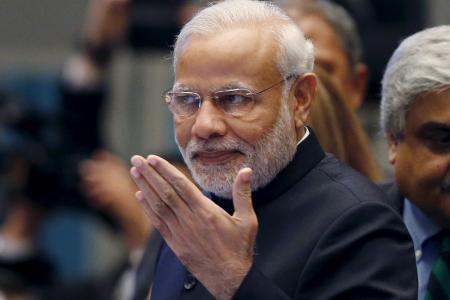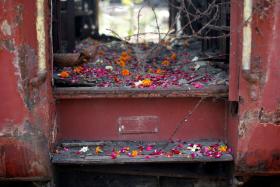Indian PM Narendra Modi in Singapore: Five things you may not know about Modi
After speaking in front of packed stadiums in London and New York City, Indian Prime Minister Narendra Modi will be here in Singapore today for a two-day visit.
This visit seeks to commemorate the 50th anniversary of diplomatic ties between India and Singapore. Both nations will further improve relations by signing the Strategic Partnership Joint Declaration.
The declaration will further cement their strong relations by further cooperating in key areas like economic cooperation, skills development, urban solutions and smart cities.
They will also speak about improving their relationship in the areas of defence, cultural exchanges, financial services, water and waste management, as well as port management.
Modi will deliver the 37th Singapore Lecture on Monday (Nov 23) night. The lecture is chaired by Deputy Prime Minister and Coordinating Minister for Economic and Social Policies Tharman Shanmugaratnam.
On Tuesday (Nov 24), Mr Modi will deliver a speech at the India-Singapore Economic Convention hosted by Minister for Trade and Industry S. Iswaran.
Then, he will visit ITE College Central together with Mr Lee, where he will learn more about Singapore's approach to vocational education and skills training.
To celebrate the meeting of the two leaders and the relations between their nations, a commemorative Singapore-India stamp issue will be released by Singapore Post.
The presidential residences of both countries - Singapore's Istana and the Rashtrapati Bhavan of India - will be depicted in the joint stamp.
A complete set of stamps will cost S$2.30, while a pre-cancelled First Day Cover affixed with stamps will cost S$3.20.
With so much fanfare surrounding Mr Modi's visit, how much do you really know about him?
Here are five things that you may not know about the Indian prime minister.
1. Used to sell tea/background
Modi had a humble background growing up and often speaks about how his family struggled to make ends meet in their hometown, Gujarat.
In a town hall-style question and answer session with Facebook co-founder Mark Zuckerberg, he spoke about coming from a poor family and selling tea at a rail station as a boy.
"It is hard to imagine that a tea seller has actually become the leader of the world's biggest democracy," he said.
An emotional Mr Modi said: "When we were small, what we used to do to get by... We used to go to neighbours' houses, clean dishes, fill water, do chores. You can imagine what a mother had to do to raise her children."
2. Modi, Silicon Valley and Holograms
It seems that it is almost essential to make an effort to visit tech giants if you're a world leader.
Both Mr Modi and more recently, Chinese President Xi Jinping, have both met the leaders of top Silicon Valley companies.
In fact, Mr Modi actually stopped by Silicon Valley during his visit to the US in September, where he met the bosses of Apple, Tesla Motors, Google (with CEO Sundar Pichai below), Microsoft, and Adobe.

And he is no doubt the most tech-savvy Indian leader.
A believer in social media, which helped fuel his win in the 2014 elections, Mr Modi has more than 16 million followers on Twitter.
Another reason for the election win? He had the help of 3m-high holograms that allowed him to address more than 100 election rallies running simultaneously.
He has been working hard to make the Internet available to more households in India.
The government announced a US$17 billion (S$24.13 billion) programme to build a national optical fibre network that will connect around 250,000 village-level governments, aiming to cover the entire country in three years.
During his visit to Google, the tech giant and Mr Modi announced a collaboration to provide wireless Internet at railway stations in India, with a goal of connecting 500 stations by the end of next year.
3. Strong ties with Singapore

Mr Modi's reputation as an effective leader was cemented when he was the chief minister of the western Gujarat state. And he has often attributed its success to being inspired by Singapore's leadership.
He has also acknowledged Singapore's key role in facilitating India's Look East Policy, and its inclusion in the inaugural East Asia Summit that happened over the weekend in Kuala Lumpur.
When Singapore's founding prime minister Lee Kuan Yew died in March, Modi ordered flags in India to be flown at half-mast as a mark of respect to Mr Lee.
Meanwhile, Singapore leaders have also regularly visited him in Gujarat and taken part in the Vibrant Gujarat Summits organised by Mr Modi.
4. Unlikely fashion icon
Is it possible to overshadow the US First Lady Michelle Obama in the sartorial department? If you are Mr Modi, the answer is yes.
Mr Modi stirred controversy when he wore a suit, that cost 1 million rupees (S$21,800) that bore his name in gold pinstripes during a meeting with Mr Barack Obama during his visit to India.
Many criticised Mr Modi and accused him of being out of touch in a nation where many live in extreme poverty. He has since auctioned off the suit where the proceeds went towards the clean-up of the Ganges river.
Mr Obama even praised Mr Modi's style at a state dinner in New Delhi in February. He said: "One of our newspapers back home wrote, 'Move aside, Michelle Obama. The world has a new fashion icon'."
5. Criticism
Since his landslide victory last year at the polls, Mr Modi has been accused by critics of further pushing India away from secularism.
Mr Modi's India has been seen by critics of being tolerant of anti-Islamic prejudice and violence. Members of his Hindu-nationalist Bharatiya Janata Party (BJP) have ramped up anti-secular and anti-Muslim rhetoric. There have been violent incidences of the lynching of a Muslim man who was accused of eating beef.
Men responsible for the attack on Sept 28 have been linked to BJP. Meanwhile, prominent critics have been killed in separate incidents by armed assassins.
Mr Modi in particular has been criticised for not speaking out against the anti-Muslim rhetoric.
The New York Times said in an op-ed: "That balancing act is in danger of teetering, imperilling not only economic development but also India's open, inclusive democracy."
Meanwhile, the BBC questioned: "Is India becoming more openly, and indeed violently, intolerant?"
Protests against Mr Modi's seemingly Hindu nationalist agenda were also seen during his visit to the United Kingdom.
A journalism professor at the Hong Kong Baptist University, Dr Cherian George,expressed in an op-ed, published on his website hope that Mr Modi could learn from Singapore's commitment to secularism and to maintaining religious and ethnic diversity.
He said: "To admire the city’s 21st century modernity and overlook how it has dealt with the deep pulls of blood and belief would be to miss the core of its identity. Like the one-of-a-kind orchid that the country offered to name after Modi, Singapore is a delicately tended hybrid."
Sources: Straits Times, The New York Times, The Financial Times, Air Conditioned Nation
Get The New Paper on your phone with the free TNP app. Download from the Apple App Store or Google Play Store now


